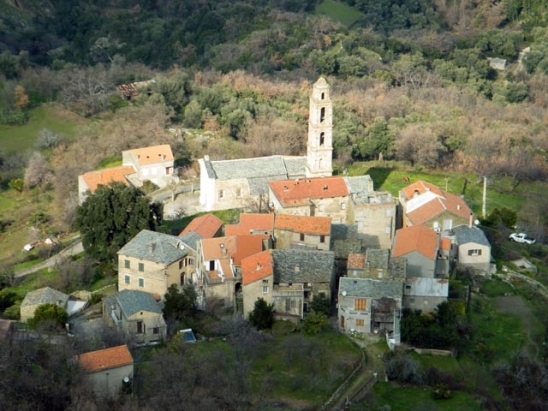I paesi di u Nebbiu trà sacru è prufanu

"Between profane and holy." That is the name of a path between Rapale and Pieve and Soriu, through some diverse points of interest, like chapels, sheepfolds, and some other old stones. Therefore, we can discover more things about le Nebbiu (Northern Corsica) and its inhabitants’ life throughout history.
This walk is a long one, and it might be better to walk it all in two separate times, so we can appreciate the different places there (Rapale-A Pieve/A Pieve-Rapale et A Pieve-Soriu/Soriu - A Pieve). We start from Rapale, more precisely from the church Santa Maria Assunta, an heritage from Pisa. There is a sign showing all the way, and all its points of interest along the way. And indeed, all along this path, there are a lot of little informative signs. We first check the altitude before we go deep through the woods. All seasons are good to discover it (the pictures have been taken in January)
The first point of interest is a small Roman chapel from the XIIIth century, which is in the process of being rebuilt : San Cesariu. It has been ranked historical monument in 1840 and it is made of serpentine, a green stone from this region, which used to be sculted. This chapel is considered like the twin of San Michele de Muratu.
After this little break, we keep on climbing towards a corniche surrounded by low maquis, which gives us an amazing view over Nebbiu’s lowlands. We spot Padula and San Fiurenzu from there. Cap Corse is also there, in the distance. We get to the village A Pieve after an hour and a half walking.
From there, we start walking again, in a high maquis space. The path splits itself but we finally get to a kind of meadows where there are lots of Pagliaghji (shepherds’ houses made of stones.) so we have the feeling to be a in an abandonned village. The path goes on and we spot the summit cross of San Damianu in the distance. On our right handside, Pieve village appears in another angle. In front us, Nebbiu meadows are lying there, to San Fiurenzu bay. On our left handside, the mountain comes accross our sight. On its side, we spot the next step of our walk : Soriu. We get to the village through some almond trees. We get close to the chapel Saint Antoine, built in the XVIth century and restored in 2002. There is a clever irrigation system (through pipes) that is crossing through the village to the washtub, and takes its source from behind the chapel.
After we crossed Soriu, we go around towards Rapele. In this last step, there is a last chapel to see, called Santa Margarite, which is an historical monument since 1936. Even though she is not literaly inside the village, she has been the sole church of Soriu, through centuries. It has been restored in 1992. Here we are, in a trip in the heart of those villages and their history, so we can learn more about their lifestyle throughout the centuries.





